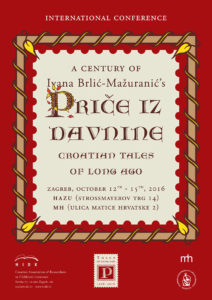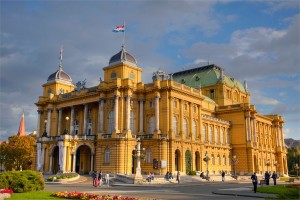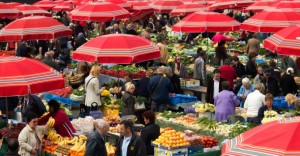A Century of Ivana Brlić-Mažuranić's Tales of Long Ago
International Conference
Zagreb, 12th– 15th October, 2016
Zagreb: tourist info
ABOUT ZAGREB
The city of Zagreb, capital of Croatia, on the historic and political threshold between East and West, illustrates both the continental and Mediterranean spirit of the nation it spearheads. Zagreb is the cultural, scientific, economic, political and administrative centre of the Republic of Croatia, and is home to the Croatian Parliament, Government and President. Its favourable location between the Pannonian plain, the edge of the Alps and the Dinaric range has allowed it to become a crossing point for mass international communication. The city is protected from the cold northern winds by the mountain of Medvednica and opens up to the rest of the world thanks to a spacious plain and the River Sava. Zagreb, with a population of nearly one million, contains almost a quarter of the entire population of Croatia. Over the centuries, the city was inhabited by people coming from all over Europe; and, in recent years, by people coming from different parts of Croatia, ensuring a rich cultural life. The façades of Zagreb’s buildings reflect the ebb and flow of history, while its streets and squares bear witness to the coming together of the many cultures that have shaped the identity of this laid-back capital.
You can find spaces for recreation almost anywhere around Zagreb. Also within easy reach we find Medvednica, a popular destination for outings. Right in the city centre, parks, streets and squares intersect with green spaces and gardens. Landscaped in the 19th century, Strossmayer Promenade in the Upper Town is where you can enjoy a romantic panorama of Zagreb accompanied by the poet A.G. Matoš, in sculpture form. Further evidence of 19th-century urban planning is provided by the so-called Green Horseshoe. This line of eight green squares created by Lenuci serves as the axis of the Lower Town. One of the most popular is Zrinjevac, known for its row of plane trees brought in from Trieste more than a century ago. Fountains, a music pavilion and busts of notable figures take us back to that time.
Those arriving by train are first greeted by lovely views of King Tomislav Square, named after the first Croatian king; the Art Pavilion and Zagreb Cathedral. The Art Pavilion, venue for special cultural events, was originally the Croatian Pavilion at the Millennium Exhibition in Budapest in 1896. Nearby nestles another green oasis, the Botanical Gardens, containing one of the most splendid plant collections in Europe, with some 10,000 varieties.
Behind the walls of the Cathedral you’ll find Ribnjak, ‘Fishpond’, a park where clergymen used to catch fish for their Friday meal. In the eastern part of the city stretches spacious Maksimir. Zagreb’s biggest park was landscaped in the 19th century, in what was considered the English style. It later became home to many animals when a zoo was opened here in the first half of the 20th century. Outside the limits of the city centre, up on the hill, stands the main cemetery of Mirogoj. Its monumental arcades, pavilions and domes were designed in the late 19th century by prominent architect Hermann Bollé. One of the most beautiful cemeteries in Europe and the resting place for many public figures, Mirogoj is a lovely park in its own right, as well as an open-air art gallery.
The cultural and artistic life of the city
Zagreb enjoys a rich cultural life. Around 30 theatres are active in the city, some with regular programmes, some occasional. Along with some 30 museums, a large number of galleries and many theatre, music and dance festivals all combine to make Zagreb a city of art. From classical to alternative, from amateur to professional, from private to public, these different artistic outlets reflect the high level of cultural awareness. The Croatian National Theatre is the national home of ballet, opera and drama. Of all the concert halls, the most prominent is the Vatroslav Lisinski, named after the composer of the first Croatian opera. Operettas and musicals, rock and pop operas can be found in the Komedija Theatre; quick-witted humour and satire are staged at Kerempuh, and contemporary productions are shown at Gavella, ZKM, ITD, and EXIT. It would be impossible to list every venue, let alone suggest the best.
Zagreb hosts many international cultural events. The World Festival of Animated Film Animafest is the second oldest of its kind in Europe. The Music Biennial, the Dance Week Festival and Eurokaz, an international festival of modern theatre, bring performers from around the world to the stages of Zagreb.
The Archeological Museum contains the mysterious mummy of a woman from Thebes in Egypt, wrapped in linen – the longest text in Etruscan still to be decrypted. The Zagreb City Museum brings a modern interpretation of historical events in the city from prehistoric times to the present day. The Museum of Arts and Crafts was founded together with a school in the same discipline in the second half of the 19th century, both established to preserve the traditional values of craftsmanship. A unique collection from different areas and periods has been on display at the Mimara Museum since the University Games were held in Zagreb in 1987. The Strossmayer Gallery of Old Masters houses a collection of works by famous painters and is an essential stop for connoisseurs of European art from the 15th to 19th centuries. Nearby we find the Modern Gallery, in which works by every significant artist from the 19th and the 20th centuries are exhibited. Zagreb has also entered the 21st century with a new building for the Museum of Contemporary Art, now opening to the public. In the Upper Town, the Klović Gallery is housed in a former Jesuit monastery. For emotion, raw life and symbolism, visit the Museum of Naïve Art, with its display of works by non-academic painters. Nearby is the Atelier Meštrović, a gallery where sculptor Ivan Meštrović used to live and create work that marked the 20th century just as profoundly as Rodin’s. The circular pavilion that is now the Hall of Croatian Artists was built on the basis of his idea. These are only some of the venues and events to give you the flavour of the rich cultural life of the city.
The gastronomic and tourist offer
Zagreb can be described as a city with the biggest lounge. The moment the sun appears in the sky in spring, restaurant, café and coffeehouse terraces open for custom. Streets become promenades, places to get a cup of coffee, relax or have a business meeting. A combination of Mediterranean cordiality and northern business sense make any visitor feel welcome. The traditional International Folklore Festival, the global festival of street performers Cest is d’Best, outdoor summer concerts on Zrinjevac, St. Martin’s Day and many other open-air events increase the feeling of communality.
Lounging in cafés has been a long tradition in this city. The Zagreb Green Horseshoe and the main square of Ban Josip Jelačić have always been hubs of social life in Zagreb. Nowadays, this has spread across the whole city centre, around the pedestrianised zone and even further. People from all walks of life can find something of interest here. Cafés around Ban Jelačić, or simply ‘Square’ as it is often referred to, attract prominent figures. Preradović, also known as Flower Square, is loved by artists and young people, as well as an older crowd. Tkalčićeva, once the border between Gradec and Kaptol, used to be full of pubs and served as the red-light district, but nowadays it is a trendy destination for rendezvous and relaxation for the whole family. The romantic among you can take the funicular on Ilica, the shortest one in the world used for public transportation – you’ll reach the Upper Town in 55 seconds. All of these locations form part of the phenomenon known as špica. Every Saturday around noon people of all ages come to the centre because that is the time and place to see and be seen. The ritual is always the same: people slowly sip coffee, read the Saturday papers, stop off at Dolac market to pick up fresh produce and then go home to prepare lunch.
The gastronomic selection in Zagreb comprises a rich combination of many cuisines. History and geography have had a great impact on menus here. Although the people of Zagreb gladly cook at home, there are many places in town where you can find specialities of inland Croatia as well as Mediterranean and international cuisine. Štrukli is one of the authentic dishes anyone in Zagreb would recommend. There are several different ways of preparation so it can be cooked or baked, sweet or salty. Turkey with mlinci pasta strips is one of the traditional meals of inland Croatia. There is also Zagreb steak, a piece of fried veal filled with cheese and ham, somewhat similar to its renowned Vienna counterpart. For breakfast you should try fresh cream with cheese bought directly from the producer, the so-called kumica, from villages around Zagreb. Another feature of the city are its open-air food markets. Almost every neighbourhood has one but the Dolac, near the Cathedral, is the best known. During the day eateries by the market offer cheap, fast, home-made dishes. There are cake shops and bakeries on every corner. We recommend you visit one of the numerous restaurants that offer regional cuisine. You should certainly try Zagreb strudel with apples, cheese or cherries, and there is also kremšnita, the most famous creamcake made in the nearby town of Samobor. We should not leave without mentioning the praised wines made from grapes grown near Zagreb.
An original souvenir from a visit to Zagreb is a tie, a must-have item of clothing in the business world and an authentic Croatian product. In the 17th century Croatian soldiers used to tie elegant scarves around their necks, a fashion later picked up by the French –the rest is history. One of the most important inventions of the 20th century, the fountain pen, was actually designed in Zagreb. Its inventor, engineer Eduard Slavoljub Penkala, patented the world’s first mechanical pencil in 1906 and in 1907 he patented the first fountain pen. The aromatic biscuit paprenjak, once made by the women of old Zagreb, is another original souvenir. It is an unusual combination of honey, walnuts and pepper and a reminder of the contrasts we find in Zagreb. The licitar, a traditional, colourfully adorned biscuit made from honey dough, originates from central Croatia and the lowlands. As it is heart-shaped, it should be given as a symbol of love and affection for special occasions. Red Šestine umbrellas, a part of traditional local attire, protect the traders at the Dolac market from sun and rain. They too form a prominent part of the city’s identity.
(source: infozagreb.hr)





